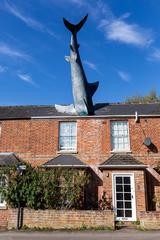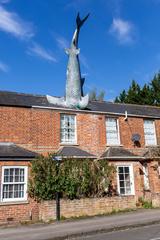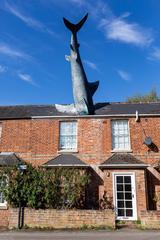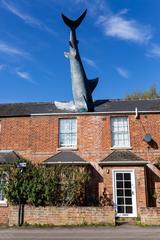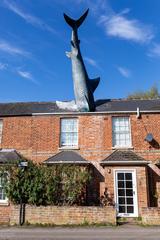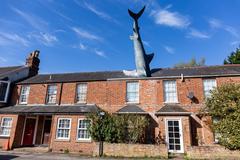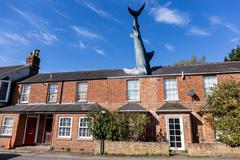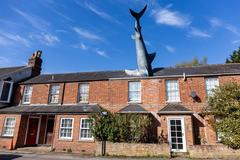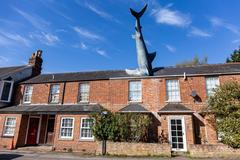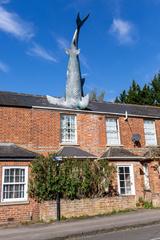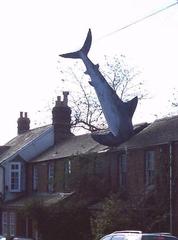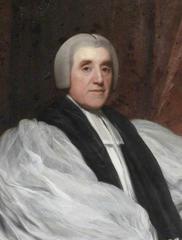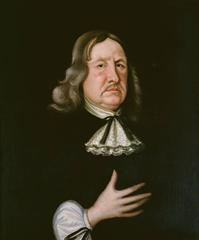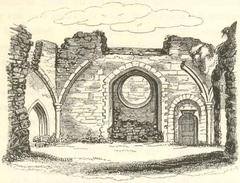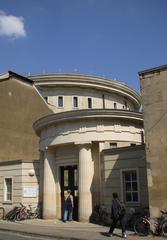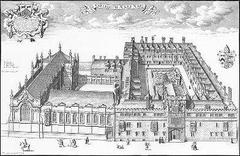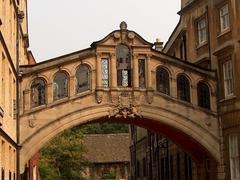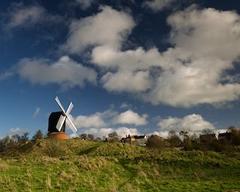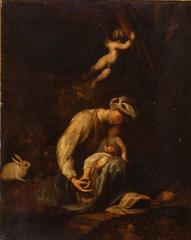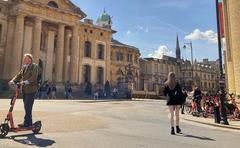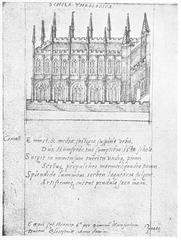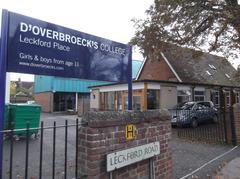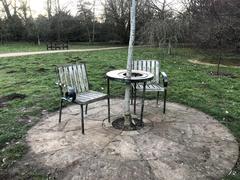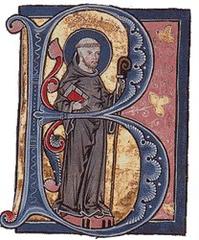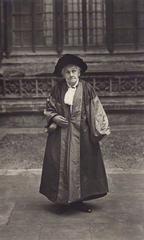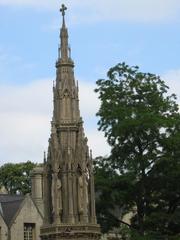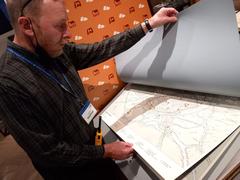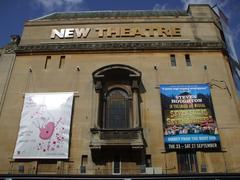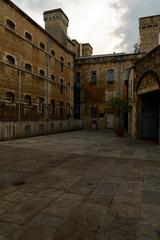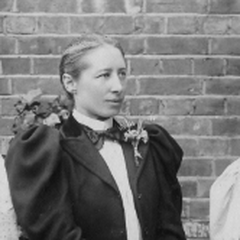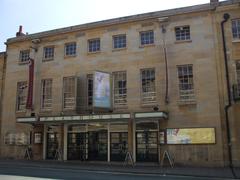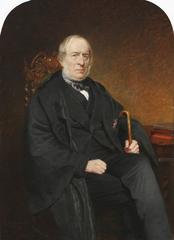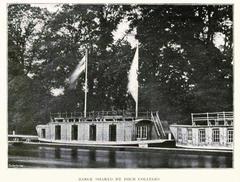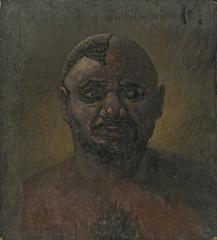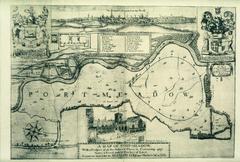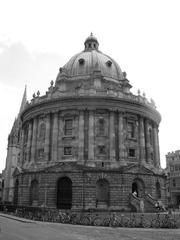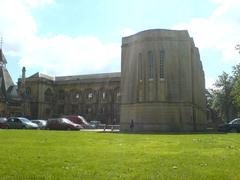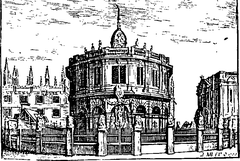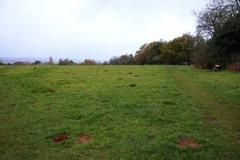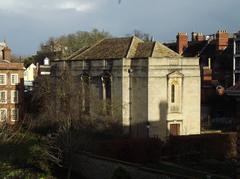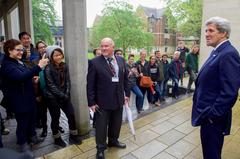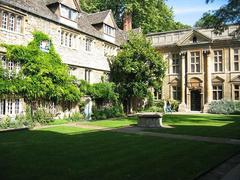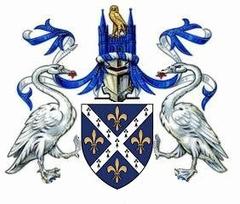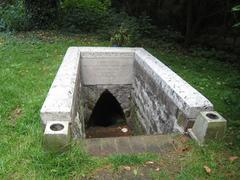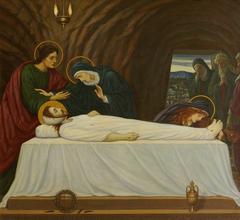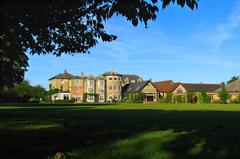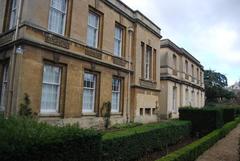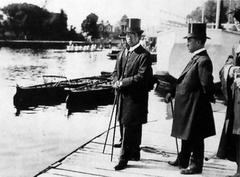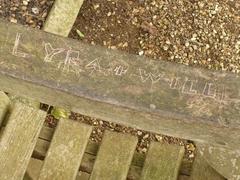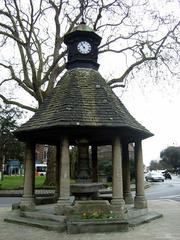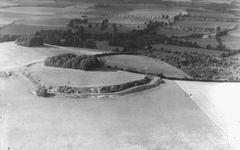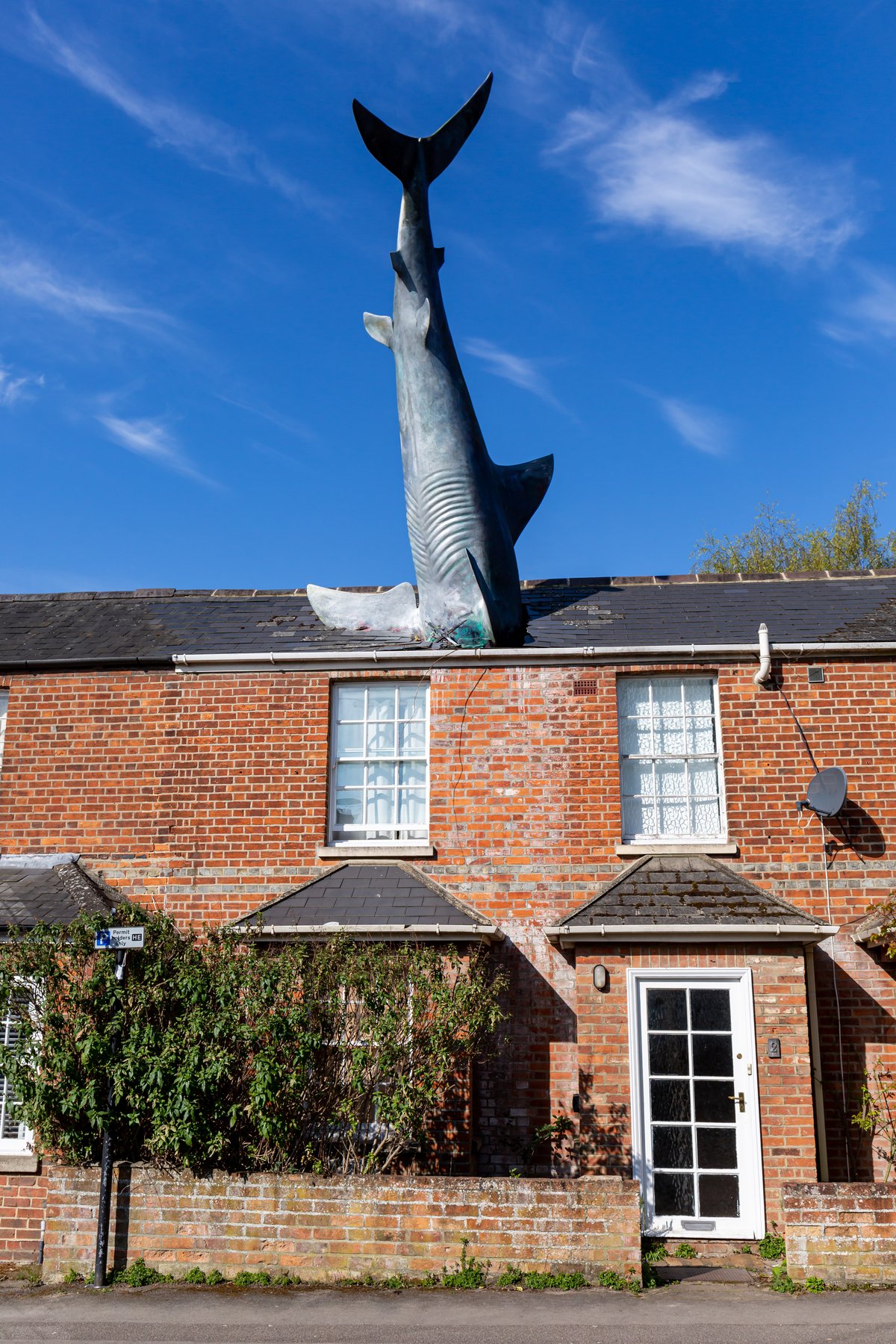
The Headington Shark: Visiting Hours, Tickets, and Historical Significance in Oxford
Date: 24/07/2024
Introduction
The Headington Shark, an iconic and unconventional landmark in Oxford, United Kingdom, captures the imagination of visitors and locals alike. Installed on August 9, 1986, the 25-foot-long fiberglass sculpture, formally titled “Untitled 1986,” features a shark crashing head-first into the roof of a house at 2 New High Street, Headington (Headington.org). Conceived by Bill Heine, an American journalist and broadcaster, and created by sculptor John Buckley, the shark was intended as a powerful political statement against nuclear weapons and the American bombing of Libya in 1986 (Oxford Mail).
The shark’s dramatic and somewhat surreal appearance quickly became a controversial topic, sparking a six-year legal battle with the Oxford City Council over planning permissions and public safety concerns. Despite initial opposition, the sculpture garnered significant local support and was eventually allowed to remain, symbolizing artistic freedom and resistance against bureaucratic constraints (Wikipedia).
Today, the Headington Shark stands as a testament to creativity, defiance, and the enduring legacy of Bill Heine. Recognized as a heritage asset by Oxford City Council in 2022, the sculpture continues to attract visitors from around the world, drawn by its unique history and cultural significance (Atlas Obscura). This comprehensive guide aims to provide detailed visitor information, historical context, and travel tips to enhance your experience when visiting this extraordinary piece of public art.
Table of Contents
- [History and Significance](#history-and-significancehistory-and-significance)
- [Origins and Installation](#origins-and-installationorigins-and-installation)
- [Legal Battles and Public Support](#legal-battles-and-public-supportlegal-battles-and-public-support)
- [Cultural Impact and Media Attention](#cultural-impact-and-media-attentioncultural-impact-and-media-attention)
- [Preservation and Heritage Status](#preservation-and-heritage-statuspreservation-and-heritage-status)
- [Legacy of Bill Heine](#legacy-of-bill-heinelegacy-of-bill-heine)
- [Visiting the Headington Shark](#visiting-the-headington-sharkvisiting-the-headington-shark)
- [Visitor Information](#visitor-informationvisitor-information)
- [Travel Tips](#travel-tipstravel-tips)
- [FAQs](#faqsfaqs)
- [Conclusion](#conclusionconclusion)
- [Additional Resources](#additional-resourcesadditional-resources)
- [References](#referencesreferences)
History and Significance
Origins and Installation
The Headington Shark, formally titled “Untitled 1986,” is a 25-foot-long fiberglass sculpture of a shark embedded head-first in the roof of a house at 2 New High Street, Headington, Oxford. The sculpture was commissioned by Bill Heine, an American-born journalist and broadcaster who had moved to Oxford in the 1960s to study at Oxford University. Heine, who worked at BBC Oxford and the Oxford Mail, conceived the idea while chatting with his friend, sculptor John Buckley, over a glass of wine (Oxford Mail).
The shark was installed on August 9, 1986, the 41st anniversary of the atomic bombing of Nagasaki. The installation was carried out in the early hours of the morning using a large crane, and it was completed just as the local postman was passing by (Headington.org). The sculpture was constructed by Anton Castiau, a local carpenter and friend of Buckley, and it took three months to build on an artificial roof outside Buckley’s studio (Oxford Mail).
Symbolism and Protest
The Headington Shark was not merely an artistic endeavor but a powerful political statement. Heine intended the sculpture as a protest against the American bombing of Libya in 1986 and as a broader statement against nuclear weapons. The shark, crashing head-first into the roof, serves as a metaphor for bombs falling from the sky, symbolizing helplessness and desperation in the face of nuclear threat (Oxford Mail).
Heine’s inspiration came from hearing American warplanes flying from Upper Heyford near Oxford on their way to bomb Libya. This event, coupled with the recent Chernobyl disaster, fueled his desire to make a bold statement about the dangers of nuclear power and warfare (Atlas Obscura).
Legal Battles and Public Support
The installation of the shark without planning permission sparked a six-year legal battle with Oxford City Council. The council initially opposed the sculpture on the grounds of public safety and later argued that it constituted unauthorized development under the Town and Country Planning Act 1971 (Wikipedia). Despite these challenges, the shark garnered significant local support, with many residents and visitors defending it as a piece of art.
The council’s attempts to remove the shark included an offer to display it in a public building, such as a swimming pool, which Heine rejected. The matter was eventually taken to the central government, where Tony Baldry, a minister in the Department of the Environment, ruled in 1992 that the shark could remain as it did not harm the visual amenity of the area (Wikipedia).
Cultural Impact and Media Attention
The Headington Shark quickly became a beloved landmark in Oxford, attracting attention from both local and international media. Bill Heine wrote a short book about the shark, published in 2011, detailing its history and significance (Wikipedia). The sculpture also inspired various creative projects, including a magazine called “The Shark” created by students from Oxford Brookes University in 2018 (Wikipedia).
The shark’s quirky and unexpected nature has made it a symbol of artistic freedom and resistance against bureaucratic constraints. It has been featured in numerous articles and has become a popular subject for photographers and tourists alike (England Rover).
Preservation and Heritage Status
In 2022, Oxford City Council added the Headington Shark to its list of heritage assets, recognizing its cultural and historical significance. This decision marked a significant shift from the council’s initial opposition to the sculpture. However, this move was not without controversy, as Bill Heine’s son, Magnus Hanson-Heine, who had been letting out the Shark House as an Airbnb, was required to apply for retrospective planning permission for change of use from residential to short-stay accommodation. This application was refused in October 2023 (Headington.org).
Legacy of Bill Heine
Bill Heine, who passed away on April 3, 2019, left behind a legacy of creativity and defiance. His installation of the Headington Shark is a testament to his eccentric and visionary nature. Heine’s other notable project included the installation of enormous can-can legs on the Headington Cinema, which he renamed “Not the Moulin Rouge” after a legal dispute with the city planners (Headington.org).
Heine’s rationale for the shark was multifaceted, encompassing feelings of impotence, anger, and desperation in the face of global threats such as nuclear power and warfare. The shark remains a powerful symbol of these sentiments, continuing to provoke thought and discussion among those who encounter it (Headington.org).
Visiting the Headington Shark
Visitor Information
The Headington Shark is located in the eastern suburbs of Oxford, approximately 3.5 kilometers (2.25 miles) from the city center. It can be easily reached by public transport, with the Oxford Bus Company Park and Ride bus route 400 and Stagecoach bus route 10 both operating frequently between Oxford city center and Headington (England Rover).
While the building itself is not open to the public, the shark can be viewed from the outside, making it a worthwhile trip for those interested in quirky and unconventional sights. The sculpture continues to attract visitors and remains a beloved part of Oxford’s cultural landscape (England Rover).
Travel Tips
- Best Viewing Times: Early mornings or late afternoons provide the best lighting for photography.
- Public Transport: Utilize bus route 400 or 10 for a hassle-free journey.
- Nearby Attractions: Consider visiting other historical sites in Oxford such as the Oxford University Museum of Natural History or the Ashmolean Museum.
FAQs
- Is the Headington Shark open to the public? While you can’t enter the building, the sculpture is viewable from the street.
- Are there any guided tours? As of now, there are no official guided tours for the Headington Shark.
Conclusion
The Headington Shark remains one of Oxford’s most intriguing and thought-provoking landmarks. Its installation in 1986 marked not only a bold artistic endeavor but also a poignant political protest against global threats, encapsulated in the visual metaphor of a shark crashing into a suburban roof. Over the years, the sculpture has weathered legal battles, public scrutiny, and preservation challenges, emerging as a celebrated symbol of artistic freedom and defiance (Oxford Mail).
Bill Heine’s visionary project has left an indelible mark on Oxford’s cultural landscape, inspiring discussions about the role of public art and the tensions between creativity and regulatory frameworks. Today, the Headington Shark continues to captivate visitors, offering a unique glimpse into the eccentric and bold spirit that defines much of Oxford’s artistic heritage (Headington.org).
For those planning to visit, the sculpture is easily accessible and can be viewed year-round. While the Shark House itself is not open to the public, the sculpture can be admired from the street, making it a must-see for anyone exploring Oxford’s rich tapestry of historical and cultural sites. Whether you’re a local or a tourist, the Headington Shark promises a memorable experience that challenges conventional norms and celebrates the power of artistic expression.
Additional Resources
For more information about the Headington Shark, visitors can explore the dedicated website maintained by Magnus Hanson-Heine, Bill Heine’s son, which includes details about the sculpture’s history, media coverage, and booking information for the Shark House (Headington Shark Website). Social media platforms such as the Headington Shark Appreciation Society on Facebook also provide updates and community discussions about the sculpture.
References
- Title: Story behind Oxford’s Headington Shark, 2021, Oxford Mail source url
- Title: The Headington Shark, 2020, Headington.org source url
- Title: Headington Shark Becomes Popular in Oxford, 2023, Oxford Mail source url
- Title: Headington Shark, 2021, Atlas Obscura source url
- Title: Headington Shark, 2020, Wikipedia source url
